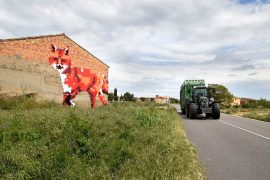
Penelles, a small town in Lleida with some five-hundred inhabitants,...
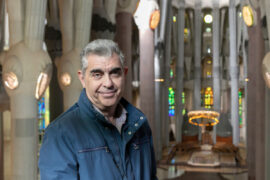
Ramon Espel has been Construction Manager at the Sagrada Família...
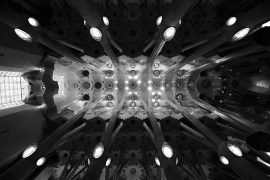
To innovate, to renew, to invent—and Gaudí did this constantly—it...

In 2018 it was 100 years since Egon Schiele’s death....

Impossibly few companies dedicated to the design sector have a...
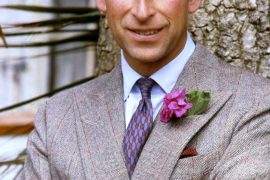
The Prince of Wales has always brought the urban and...
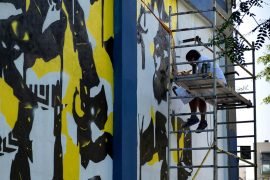
A new breed of street art fills Barcelona with new...
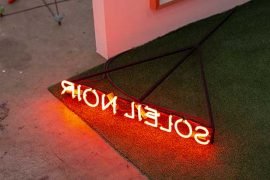
The eleventh edition of the Barcelona Art Fair featured the...
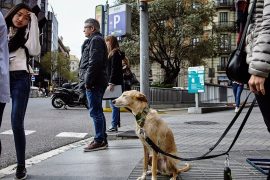
Urquinaona is a non-square, if I may be allowed to...
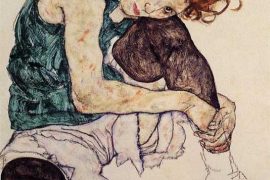
On October 31st is commemorated the centenary of Egon Schiele’s...

Música clásica sobre la arena de la playa en dos...

The first session of the cycle on the regatta organized...

The hospital's managing director, Manel del Castillo, and the pharmaceutical...

Generalitat y Ayuntamiento impulsarán dos equipamientos de 'Casa de les...

Leticia Beleta, director of Alexion Pharmaceuticals in Spain and Portugal,...

We all have a friend who never leaves the Gràcia...

Barcelona director opts for Best International Film with 'La sociedad...

The hotel and industrial sectors softened the market's decline last...

The technology company, with a workforce of 35 employees and...

“The women of yesteryear were strong and had to fight...
[dropcap letter=”E”]
mmanuel Guigon (Besançon, 1959) became the director of the Picasso Museum in February 2017 and he applied his way of understanding cultural management after a few months. Gaunt, dynamic and entertaining conversationalist, this doctor of Contemporary Art History from the Sorbonne has turned the autopilot off and is steering the museum towards broader Picassian horizons. “We have to put an end to the idea that this is a museum for tourists, we also have to attract locals. And we can only achieve this with attractive and transversal temporary exhibitions“. The first decision: to extend opening times and open on Mondays in the summer months. Result: two thousand five hundred more people every Monday. The museum will be open every Monday between March 1 and September 30, 2018, accompanied by a pulsating exhibition rhythm.
Recently, the Montcada Street museum has had one hundred thousand more visitors than in 2016, with four simultaneous temporary exhibitions: “1917. Picasso in Barcelona”; “The Shared Studio. Picasso, Fín, Vilató y Xavier”; “Lucien Clergue, twenty-seven meetings with Picasso” and “Arthur Cravan. Maintenant?”
In 1917, Barcelona was profiting from the Spanish neutrality in World War I. Patrons toasted with champagne. And Picasso arrived with his first wife, Olga Khokhlova. He stayed for six months, from June to November, at the same time as Diaguilev’s Russian ballets’ début and enjoyed the bubbly hustle and bustle. Guigon shows us the photos that immortalized the reunion of the malagueño with his adoptive city: at Tibidabo, la Rambla, overlooking Paseo de Colón. A receipt from the Balneario Oriental hotel at Coma-ruga evokes a trip to the beach on July 14 a century ago. It’s for 25.75 pesetas broken down into the following concepts: 5 for the transfer by spring cart, 12 for the accommodation at the hotel and 8.75 for extraordinary expenses.
After admiring the canvases Picasso painted in Barcelona in 1917 –the Paseo Colón from the balcony with the Spanish flag, Olga wearing a shawl sitting on her armchair and his famous Harlequin– we can confirm the “Guigonian” philosophy of what a 21st century museum should be like: “In addition to conserving the assets and restoring and incorporating new works, it must enhance its scientific role: collaborating with universities on doctoral theses and studies, strengthening the research centre; work on their own programmes: in 2018 we will launch the Quaderns Picasso; pose a radical dialogue with 21st century culture on Picasso: about him or against him“. And all this without forgetting the opening to new segments of the public: “The museum must become a local cultural agent, and not just a place to be visited,” the director insists.
Guigon comes from a cultured family, between France and Switzerland. He had a great library at home and while he started becoming fond of art, literature and poetry, his father played records by Charlie Parker and Thelonious Monk. He admired his first Picasso painting when he was only ten years old at an exhibition at The Pope’s Palace in Avignon. Three decades later –in 1985, when he already had his doctorate– he lived in Barcelona for a year and a half and walked up and down Montcada Street quite a few times, aligning his passion for artistic vanguards with Rafael Santos Torroella and J.V. Foix’s wise annotations or immersing himself in Torres García’s work. More than Picassian, Guigon confesses he’s a Bretonian: “By following my studies on the art of assembly and collage, encountering Picasso was inevitable: I wrote a history on collage in Spain and, of course, there he was,” he says.
Guigon sits pensively in a wicker chair before the cubist Las Meninas. Another anniversary: sixty years of the fascinating exploration of Velazquez arrayed in 58 pieces: “When his friend Sabartés died, Picasso donated it to Barcelona for his museum,” he says. We pose a tricky question. Remembering John Berger’s ruthless commentary in The Success and Failure of Picasso about the painting: “He empties it of its own content and then is unable to find any other for his own. It remains a technical exercise. If there is any implicit fury or passion, it is that of the artist condemned to paint without having anything to say…“.
Picasso was fascinated by boxing: we can see it in his pugilistic poses in some photos and the tickets to matches that still exist.
More than in subjective and watertight opinions, the Picasso Museum director is interested in all the ways of admiring art: its transversality, with new technologies, its permanent dialogue with other creative disciplines.
As a programmatic theory, it always sounds good, but what about a practical example? 2018 will be the first year the museum has been solely directed by Guigon. For example, an exhibition on Picasso and cuisine with a multidisciplinary vocation: “The relationship between the painter and gastronomy has never been addressed, an issue that is present throughout his work since he put the menu for Els Quatre Gats together. Picasso ate very little and worked a lot. The kitchen interested him as a space. He painted cubist still lifes like Le Bouilloncube, kitchen utensils; he spoke of food in texts before Ionesco or Beckett; he illustrated Apollinaire’s Alcools; he expressed an erotic relationship with food: he participated in dinners to celebrate his friends; drew on playing cards at Le Catalan brasserie.”
What work would you save if you had to evacuate the museum? Guigon doesn’t look surprised at the question. “If they aren’t destroyed, in which case there’s no solution, works of art never disappear, they always end up somewhere because they have economic value”, he says. “I would keep one of his training pieces, Science and Charity; this oil painting created in Barcelona in 1897 will be restored in Paris next year and will feature a study, the sketches of the work and the photographs published by Paris Match at the end of the sixties”.
In another room of the museum, we’ll run into Arthur Cravan, the poet-boxer who sought adventure in the ring and claimed to be Oscar Wilde’s nephew. Cravan fought Jack Johnson on April 23, 1916 and was depicted on canvas in the sixth round. Picasso was fascinated by boxing: we can see it in his pugilistic poses in some photos and the tickets to matches that still exist. Guigon commissioned this exhibition to tell us that Picasso considered boxing, with its dose of struggle, spectacle, strength and courage, a “metaphor of creation”. Seconds out! We imagine the painter in shorts; his workshop like a ring: each brush stroke, a round, each work of art a fight. Let inspiration surprise us while working, they say he said.
[dropcap letter=”E”]
mmanuel Guigon (Besançon, 1959) became the director of the Picasso Museum in February 2017 and he applied his way of understanding cultural management after a few months. Gaunt, dynamic and entertaining conversationalist, this doctor of Contemporary Art History from the Sorbonne has turned the autopilot off and is steering the museum towards broader Picassian horizons. “We have to put an end to the idea that this is a museum for tourists, we also have to attract locals. And we can only achieve this with attractive and transversal temporary exhibitions“. The first decision: to extend opening times and open on Mondays in the summer months. Result: two thousand five hundred more people every Monday. The museum will be open every Monday between March 1 and September 30, 2018, accompanied by a pulsating exhibition rhythm.
Recently, the Montcada Street museum has had one hundred thousand more visitors than in 2016, with four simultaneous temporary exhibitions: “1917. Picasso in Barcelona”; “The Shared Studio. Picasso, Fín, Vilató y Xavier”; “Lucien Clergue, twenty-seven meetings with Picasso” and “Arthur Cravan. Maintenant?”
In 1917, Barcelona was profiting from the Spanish neutrality in World War I. Patrons toasted with champagne. And Picasso arrived with his first wife, Olga Khokhlova. He stayed for six months, from June to November, at the same time as Diaguilev’s Russian ballets’ début and enjoyed the bubbly hustle and bustle. Guigon shows us the photos that immortalized the reunion of the malagueño with his adoptive city: at Tibidabo, la Rambla, overlooking Paseo de Colón. A receipt from the Balneario Oriental hotel at Coma-ruga evokes a trip to the beach on July 14 a century ago. It’s for 25.75 pesetas broken down into the following concepts: 5 for the transfer by spring cart, 12 for the accommodation at the hotel and 8.75 for extraordinary expenses.
After admiring the canvases Picasso painted in Barcelona in 1917 –the Paseo Colón from the balcony with the Spanish flag, Olga wearing a shawl sitting on her armchair and his famous Harlequin– we can confirm the “Guigonian” philosophy of what a 21st century museum should be like: “In addition to conserving the assets and restoring and incorporating new works, it must enhance its scientific role: collaborating with universities on doctoral theses and studies, strengthening the research centre; work on their own programmes: in 2018 we will launch the Quaderns Picasso; pose a radical dialogue with 21st century culture on Picasso: about him or against him“. And all this without forgetting the opening to new segments of the public: “The museum must become a local cultural agent, and not just a place to be visited,” the director insists.
Guigon comes from a cultured family, between France and Switzerland. He had a great library at home and while he started becoming fond of art, literature and poetry, his father played records by Charlie Parker and Thelonious Monk. He admired his first Picasso painting when he was only ten years old at an exhibition at The Pope’s Palace in Avignon. Three decades later –in 1985, when he already had his doctorate– he lived in Barcelona for a year and a half and walked up and down Montcada Street quite a few times, aligning his passion for artistic vanguards with Rafael Santos Torroella and J.V. Foix’s wise annotations or immersing himself in Torres García’s work. More than Picassian, Guigon confesses he’s a Bretonian: “By following my studies on the art of assembly and collage, encountering Picasso was inevitable: I wrote a history on collage in Spain and, of course, there he was,” he says.
Guigon sits pensively in a wicker chair before the cubist Las Meninas. Another anniversary: sixty years of the fascinating exploration of Velazquez arrayed in 58 pieces: “When his friend Sabartés died, Picasso donated it to Barcelona for his museum,” he says. We pose a tricky question. Remembering John Berger’s ruthless commentary in The Success and Failure of Picasso about the painting: “He empties it of its own content and then is unable to find any other for his own. It remains a technical exercise. If there is any implicit fury or passion, it is that of the artist condemned to paint without having anything to say…“.
Picasso was fascinated by boxing: we can see it in his pugilistic poses in some photos and the tickets to matches that still exist.
More than in subjective and watertight opinions, the Picasso Museum director is interested in all the ways of admiring art: its transversality, with new technologies, its permanent dialogue with other creative disciplines.
As a programmatic theory, it always sounds good, but what about a practical example? 2018 will be the first year the museum has been solely directed by Guigon. For example, an exhibition on Picasso and cuisine with a multidisciplinary vocation: “The relationship between the painter and gastronomy has never been addressed, an issue that is present throughout his work since he put the menu for Els Quatre Gats together. Picasso ate very little and worked a lot. The kitchen interested him as a space. He painted cubist still lifes like Le Bouilloncube, kitchen utensils; he spoke of food in texts before Ionesco or Beckett; he illustrated Apollinaire’s Alcools; he expressed an erotic relationship with food: he participated in dinners to celebrate his friends; drew on playing cards at Le Catalan brasserie.”
What work would you save if you had to evacuate the museum? Guigon doesn’t look surprised at the question. “If they aren’t destroyed, in which case there’s no solution, works of art never disappear, they always end up somewhere because they have economic value”, he says. “I would keep one of his training pieces, Science and Charity; this oil painting created in Barcelona in 1897 will be restored in Paris next year and will feature a study, the sketches of the work and the photographs published by Paris Match at the end of the sixties”.
In another room of the museum, we’ll run into Arthur Cravan, the poet-boxer who sought adventure in the ring and claimed to be Oscar Wilde’s nephew. Cravan fought Jack Johnson on April 23, 1916 and was depicted on canvas in the sixth round. Picasso was fascinated by boxing: we can see it in his pugilistic poses in some photos and the tickets to matches that still exist. Guigon commissioned this exhibition to tell us that Picasso considered boxing, with its dose of struggle, spectacle, strength and courage, a “metaphor of creation”. Seconds out! We imagine the painter in shorts; his workshop like a ring: each brush stroke, a round, each work of art a fight. Let inspiration surprise us while working, they say he said.
